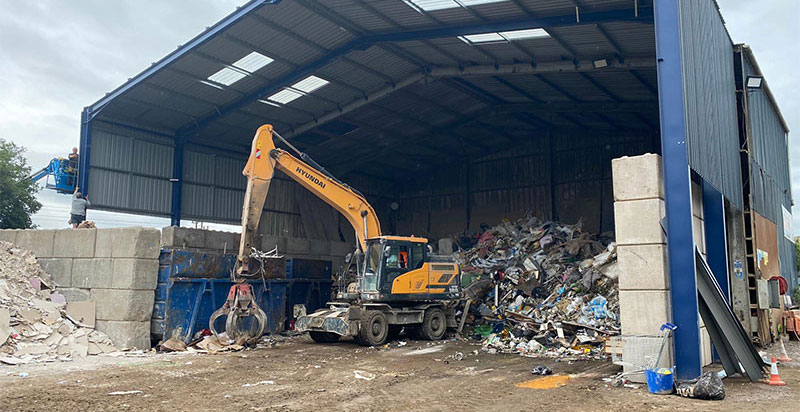Fires at waste yards, recycling centres and materials-recovery sites aren’t just disruptive — they’re dangerous, expensive, and increasingly the focus of tightened regulation.
Small waste operators now face stronger expectations from regulators (notably the Environment Agency in England and Wales) to have robust Fire Prevention Plans (FPPs) and physical measures that reduce ignition risk and stop fires spreading between stockpiles.
Concrete interlocking block systems — like Elite Precast’s Legato® and Duo™ blocks — are a practical, cost-effective way to meet those expectations while keeping operations flexible, according to Owen Batham, Sales and Marketing Director at Elite Precast Concrete and here’s how.
Why regulators and inspectors are pushing for concrete compartmentation
Recent and ongoing guidance (and permitting decisions) emphasise that operators must manage combustible materials to reduce the likelihood and impacts of fires — by segregating stockpiles, limiting pile sizes, providing safe access, and documenting mitigation in a Fire Prevention Plan.
The Environment Agency provides a Fire Prevention Plan template and expects operators to adopt appropriate mitigations for material storage. Independent industry guidance also stresses compartmentation, good housekeeping, and engineered site measures as core ways to reduce risk at waste sites.
What Legato® and Duo™ blocks bring to the table (and to your FPP)
Elite Precast manufactures two interlocking concrete block systems widely used for bulk storage, segregation walls and bays:
Legato® interlocking blocks — engineered, high-strength blocks designed for permanent or long-term walls and bays are suitable for high walls and heavy-duty storage.
Duo™ interlocking blocks — robust, modular blocks intended for flexible, reconfigurable bays and temporary works. They’re dry-laid, easy to relocate, and well suited to changing operational layouts.
How that helps your fire compliance
Compartmentation that limits fire spread
Concrete block bays create physical fire breaks between different waste types and stockpiles. By separating combustible streams (e.g., wood, plastics, mixed waste), you reduce the chance that a single ignition will spread across the whole site — a key objective of an FPP. Both Legato and Duo are designed to form continuous, interlocking walls that are stable even at large heights, giving you reliable compartmentation.
Thermal mass and non-combustibility
Concrete doesn’t burn. Walls made from concrete blocks provide thermal buffering and reduce radiant heat transfer between bays — helping protect adjacent piles and site infrastructure while a fire is dealt with. This is an advantage flagged in multiple fire-risk guidance documents as part of engineering controls.
Flexible, regulator-friendly layouts
The systems are designed for easy relocation and reconfiguration, which helps operators adjust bay sizes to comply with permitted pile height/volume limits or to implement changes recommended in an FPP without expensive permanent works. They lend themselves to more permanent segregation where needed (e.g. long-term stockpiles or heavier materials).
Faster, safer firefighting and access control
Well-designed block bays create logical access corridors and predictable pile layouts, which supports safe fire service access and firefighting plans described in many FPPs. They also make it easier to implement water-delivery plans, hydrant placement, and isolation strategies required by permit conditions.
Clear evidence for permits and inspections
When you include engineered compartmentation (with product specs and photos) in your Fire Prevention Plan, inspectors can clearly see the mitigations you’ve implemented — which helps when applying for or maintaining environmental permits and when responding to enforcement queries. Relevant permitting decisions increasingly reference “appropriate measures” for storage and emissions control.
Practical ways to use Legato® & Duo™ in your FPP and on site
Here’s a checklist of concrete, inspector-friendly actions small waste operators can take:
- Map your material streams and designate permanent bays and flexible bays for different waste types. Include this map in the FPP.
- Define pile height/volume limits per bay to match permit conditions and keep records of stock levels. Concrete bays make it easy to visualise and enforce these limits.
- Install clear separation distances and access routes for firefighting appliances — plan these into the bay layout.
- Use concrete bays for high-risk materials (e.g. plastics, RRC fines, baled RDF) so high thermal mass reduces heat transfer to adjacent stores.
- Keep documented inspection and maintenance logs for bay integrity, block condition, and drainage — attach these to your FPP and permit folder.
- Train staff and contractors on bay reconfiguration and emergency procedures tied to the bay layout — regulators look for training evidence during audits.
Design and installation considerations (so your solution also withstands scrutiny)
- Foundation and surfacing: Blocks are dry laid but need a firm, level base. Document the ground preparation in the FPP and supplier drawings.
- Wall height and stability: Elite product literature and technical sheets provide guidance on workable wall heights per block type, which should always be checked by a structural engineer — include those specs in permit submissions.
- Drainage and runoff: Ensure water management doesn’t allow pooling around bays (standing water can exacerbate some risks and impede firefighting). Include drainage plans in your site layout.
- Material compatibility: Match bay type to the waste stream. Elite concrete blocks are ideal for both permanent storage bays for long-term or heavy materials and for short-term or frequently changed inventories.
A short regulatory reality check
Regulators expect operators to have a documented Fire Prevention Plan and to implement “appropriate measures” for the storage and management of combustible waste — from planning pile sizes and segregation to engineering measures like compartmentation. Using certified concrete block systems and including their specifications and layout diagrams in your FPP demonstrates a proactive, evidence-based approach.
Why Elite Precast is a smart partner for small operators
Elite Precast’s Legato® and Duo™ systems offer proven, practical engineering controls that directly address the major components regulators want to see in an FPP: compartmentation, non-combustible barriers, flexibility, and traceable product performance.
For small operators working with limited budgets, these block systems let you meet fire-safety expectations without lengthy permanent construction or downtime — and they give you clear, auditable evidence to include in permit applications and site inspections
For more information, please speak to Owen directly on 01952 588885 or email sales@eliteprecast.co.uk












